Vintage radios
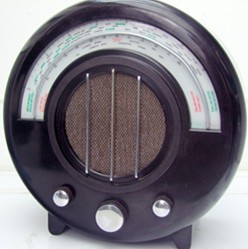
Collecting vintage radios is a well established hobby. You can choose from art deco sets from the 1930s, contemporary table radios from the 40s and 50s, or transistor sets from the swinging sixties. There is a strong following for high quality receivers from the 60s and 70s. These were the most expensive portable radios of their time and still give great reception today. Look out for radios made by Hacker, Roberts and Bang and Olufsen.
Most vintage radios still work today, although many can only receive medium wave (MW) and long wave (LW). A number from the late 50s onwards can receive FM. Of course if digital radio becomes universal they will all be obsolete, although it is highly likely that someone will make a converter to allow vintage radios still to be used.
Valve radios
1920s and 1930s
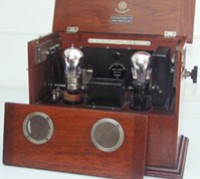
The BBC's first radio service to the UK was in 1922. In those days you could buy a crystal set that needed no external power, but could only power head phones, or an early valve radio. In the early 20s radios tended to look like a piece of scientific equipment.
Towards the end of the 1920s manufacturers started to put their radios in attractive cabinets which did not leave the valves on open display. The 1930s was the golden age of radio cabinet design. Manufacturers made some beautiful art deco designs featuring clouds, sun rays, lightening flashes and Aztec pyramid shapes. Radio was a high value consumer product and leading designers such as R D Russell and Wells Coates designed radio cabinets. Coates' circular radio became a classic of the era.
Collectors' tips
Bakelite radios are worth more than wooden ones. However, the market has remained static for many years. Wooden art deco cabinets are more of a bargain. Look for ones with obvious art deco motifs: clouds, sunbursts, lightening flashes and Aztec pyramids.
Values: Ekco AD65 design by Wells Coates in brown Bakelite - £700; Pye radio with sun and clouds motif in walnut case £50 - £100.
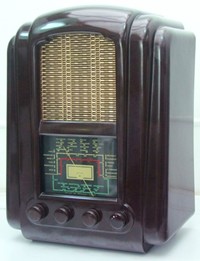
When war broke out in 1939, like many other businesses radio manufacturers worked with the Government to design military equipment. Technology moved on quickly, but the public had to wait until after the war to see the benefits.
In spite of shortages of components and other restrictions, radio manufacturers quickly launched new models onto the market. The first post-war radio was the Ferranti 145, launched in September 1945. Its Odeon style Bakelite cabinet featured a softer version of the art deco stepped pyramid.
Other manufacturers also continued pre-war styles. Ekco produced a few new designs based on Wells Coates' original classic from 1934.
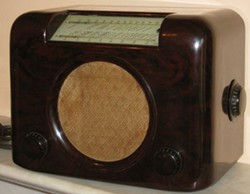
The Utility Scheme during the war had shown manufacturers could make simple, well designed products. After the war, the new Labour Government was keen that post-war products should also be well made and well designed. The 'Britain Can Make It' Exhibition of 1946, held in the Victoria and Albert Museum in London, gave manufacturers of all sorts an opportunity to showcase new designs. The British radio industry of 1946 was in the vanguard of innovation. They displayed twenty-five new radios, including some innovative designs which pushed the public's idea of what a radio should look like. They included the Emor Globe radio, shaped as the name suggests, the Murphy Baffle, shaped like a curved speaker baffle and the portable Romac 106, which could be carried on the shoulder like a camera. However, the set that defined the new era was the Bush DAC 90, which became one of the best selling radios of the time.
Values: Bush DAC90 and 90A £50 - £150
1950s
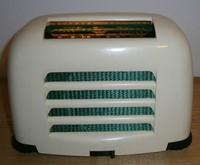
At the beginning of the 50s the table radio set that was popular in the 1930s still performed its role as a focus of news and entertainment for the family. However, that role was usurped by the television set by the end of the decade. Television came to the UK at a time of rising affluence and by the end of the decade nearly three quarters of the population had access to a TV.
Nevertheless, table valve radios were still produced in the 50s and some of the most attractive Bakelite sets date from the early to mid 50s. One of the most collectible is the KB FB 10 made by Kolseter Brandes in 1950. It became known as 'the Toaster', mainly because of the set design, but also because reputedly, it could get as hot as a toaster.
From the middle of the decade onwards, table radios became increasingly sophisticated. The ultimate table valve radios were those made by Grundig, some of which had cable operated remote control.
Cabinet design followed contemporary furniture style. In the 30s it had been art deco, in the 50s it was modernism, led by the Festival of Britain and later Scandinavian style. By the end of the decade, table radios were discretely modern and followed the low, long look of Scandinavian furniture.
Collectors' tips
Avoid radios with cracked or damaged Bakelite cases, they are worth a lot less than undamaged ones. Repairing these radios is a specialised job, so it is better to check working condition before parting with cash; although a mint condition non-working radio is far better than a cracked one in full working order.
Values: KB FB 10 'Toaster' - £50 to £100.
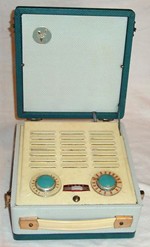
Valve portables
The earliest portable radios appeared in the 1920s. There was a portable version of the Pye radio in polished walnut, featuring the sun ray and cloud pattern popular in the the art deco era. However, these radios were often as big and as heavy as a small suitcase. Advances in technology during WWII made miniature valves a possibility and the size of portable radios came down quickly in the 1950s.
There were two types of portable valve radio. Those that looked like a radio with a carrying handle, and those that looked like a small brief case and later a small handbag. Early Bakelite portables are the most collectable of this type.
In the middle of the 50s, a number of small handbag sized radios were made, such as the Vidor Lady Margaret and the Ever-Ready Sky Countess. The appeal of these radios was generally to women. The radios opened like a small case and the controls were on the top. The cases were often decorated in a fashionable pattern, such as polka dots.
The true classic of the era was once again made by Bush. David Ogle designed the Bush MB60 in 1956. Its smooth cream plastic case and oversized circular tuning dial have made it a classic of the Rock'n'Roll era.
These valve portables had a brief flowering in the 50s, but were quickly superseded by transistor radios which were significantly smaller and lighter..
Values: Vidor 'Lady Margaret' £25 - £75; Bush MB60 £50
Transistor radios
1950s
The transistor radio conjures up images of teenagers in the 60s listening to pop music on sets made in Japan or Hong Kong, but in the 1950s, transistor radios were an expensive novelty.
The transistor was invented in 1948 and the first transistor radio, the Regency TR-1, was in shops in the USA in time for Christmas 1954. It was a neat and conservatively styled shirt pocket radio. The restrained modernism of the TR-1 was quickly brushed aside in 50s' America by colourful Japanese imports which took their styling cue from US automobile design.
Britain's first transistor radio, the Pam 710, did not appear until 1956. Unlike its American cousin, the Pam was by no means shirt pocket sized. It was around the same size as a contemporary valve portable. Pam was made by Pye, but Pye executives decided not to risk their name on a new technology.
Other UK transistor radios soon appeared. They resembled very closely valve models from the same manufacturer. The Bush TR82 looked identical to the MB60, except it used transistors.
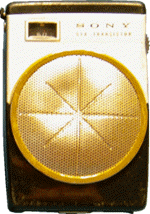
1960s
British manufacturers did finally catch-up with the idea of pocket or personal transistor radios in the late 50s and the first personal radios appeared. Initially import restrictions kept Japanese sets out of Britain, but all that changed in 1960. Sony had started manufacturing in the Republic of Ireland and a new agreement with the UK Government meant that sets could come from Japan as well.

The first transistor radios to come from Japan were the Sony TR620 and the Toshiba 6TP354. British manufacturers feared the worst. However, they did not give up without a fight and the first transistor radio to break the £10 barrier was British: the Fidelity Coronet from 1961. They even managed to get Cliff Richard to promote it, linking very clearly the world of pop music and the transistor radio. In that year over two million transistor sets were sold in the UK, more than all valve radios.
The pocket transistor radio became the symbol of the swinging 60s, with millions of teenagers tuning into Radio Luxembourg or Radio Caroline on a pocket transistor radio. However, British manufacturers failed to compete on price with the Far East and by the mid sixties even if you could find a transistor set with a British brand, it more often than not was made in Japan or Hong Kong.
Collectors' tips
There is a small, but growing market in personal radios from the 60s. Look for models in good condition by well known brands such as Perdio, Pye, Ferguson, Bush, Fidelity, Murphy and Zenith. Also look out for early Japanese models by Sony, Sanyo, Toshiba and Sharp.
Values: Fidelity Coronet transistor radio £35; Perdio Picadilly £35; Sony TR63 £50
Prestige radios
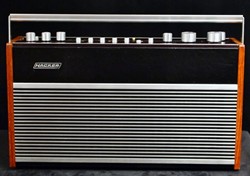
The British firms still dominated the top end of the portable radio market in the 60s. UK firms Hacker and Roberts competed with German rival, Grundig and Danish firm, Bang and Oulefsen, for the prestige radio market. All four companies made radios of superlative quality and which are very collectable today.
The first Hacker radio was the Hacker Herald RP10 from 1960. The Sovereign, offered sound quality to rival the best radios manufactured today. The ultimate Hacker was the Super Sovereign from the 70s.
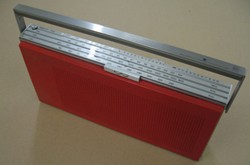
Roberts first transistor radio, the RT1, formed the basis of today's Revival 250 series. The original Rexine covered sets from the 50s are very collectable.
Perhaps the ultimate expression of design was the Bang and Olufsen Beolit 700 from 1970. It combined high quality electronics with a minimalist design.
The early 70s saw an interest in radios capable of receiving short wave (SW) as well as MW, LW and FM. The Grundig Yacht Boy was the radio that set the standard.
The most collectable transistor radios today are the Bang and Olufsen Beolit, the Grundig Yacht Boy and the Hacker Sovereign.
- Read more:
- Roberts radios
Collectors' tips
Collectors look for sets in 'as new' or mint condition. Sets in good condition with only minor defects are worth significantly less.
Values: Hacker Sovereign £50 - £200; Roberts RT1 £20 - £100; Grundig Yacht Boy £40 - £150; Bang & Oulfsen Beolit (1970) £60 - £200. (These price ranges reflect sets in working order and good, usable condition, at the bottom of the range, up to sets in almost mint condition at the top.)
Resources
If you are serious about vintage radio purchase a copy of
Radio!, Radio!
by Jonathan Hill. It is a superbly detailed reference about radios from the
early days to the 1960s. I would strongly recommend it.
Radio Art
by Robert Hawes was also useful in writing this article. It features a large
number of colour pictures of vintage radios.
By Steven Braggs, 2012


Comments
damn bro, love them radio.